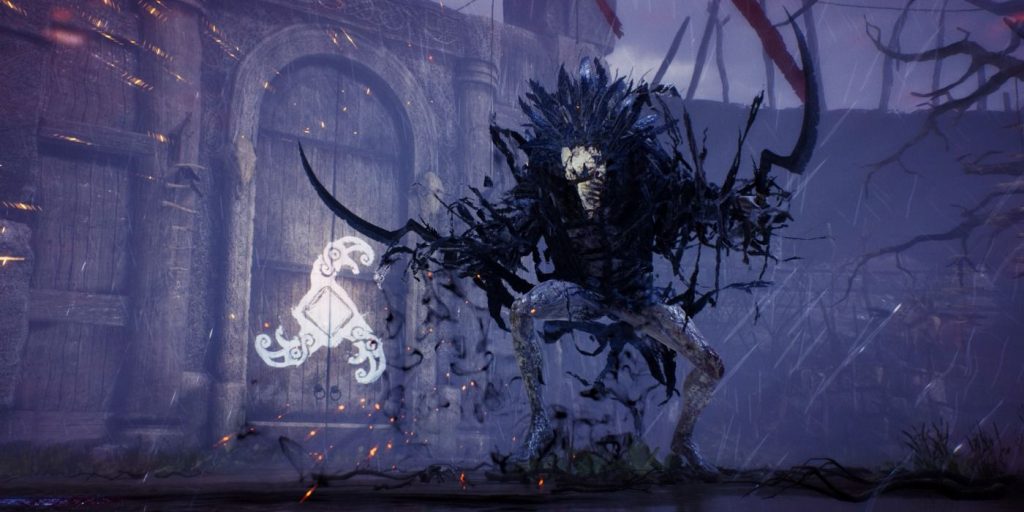Hellblade: Senua’s Sacrifice has been on my radar for quite a while. I finally got around to playing it over the weekend and I’ve never been more instantly hooked by a game. It’s a dark descent into both Norse folklore and mental illness, and it handles the latter brilliantly. I’ve dealt with mental illness a lot in my personal life, and have been working for a mental health charity seasonally for about eight years, so I’m glad Ninja Theory consulted professionals and people with actual mental illnesses to ensure it represented lead character Senua’s psychosis honestly. Throughout Hellblade, it nails the way intrusive thoughts work, but their inclusion in the game’s combat is where the feature is most impressive.
As we’re introduced to Senua, we’re also greeted by the many voices in her head that accompany the exiled Celtic warrior on her journey towards Helheim. These include a narrator, who delivers exposition and often breaks the fourth wall; Druth, her dead friend who knows about the legends and mythos of the Norsemen due to being enslaved by them; and the Furies, multiple voices that help or hinder Senua seemingly on a whim. Also present is the Darkness, a malicious presence that torments Senua as she attempts to free the soul of her dead lover, Dillion. I normally play games through my TV speakers and with subtitles on, but this is an experience best had with headphones alone. Only catching a snippet of a voice without being sure of who it belongs to is the best way to explore Senua’s state of mind.
RELATED: Having A Game Backlog Hits Differently When You Have Depression
While the narrator provides overarching plot information, Druth helps with the specifics of puzzle-solving. The Furies can be helpful, but more often than not they are disparaging, telling Senua, and by extension, you, that the journey you’re on cannot be completed – that you are destined to fail. They’re especially loud during combat, adding to the cacophony of ringing steel and demonic grunts. Aside from the noise, the combat is smooth, easy to learn, weighty, and complemented by incredible animations. Senua’s moves could use some more variety, but other than that, it’s perfect.
During the first fight, demons with deer skulls approach one by one. Combat sees Senua transform from a fearful wreck into a brutal warrior – she acrobatically spins around, blocks heavy blows, and viciously attacks with running kicks and the hilt of her sword. But despite how powerful she is, the Furies are always there. If you mistime a block and get attacked, the Furies start to hurl abuse at you, first whispering, and then shouting. “You can’t do it! He’s too strong! You’re going to die!” They infect you, making you believe you’re doomed. Senua can get knocked down, but if you mash X she gets back up, defiantly. Proving the voices wrong is cathartic, while succumbing to them is devastating – Hellblade perfectly captures the essence of fighting your inner demons by pitting you against the real thing.
As the game progresses, the fights get harder. First through the introduction of more enemies, then by throwing stronger ones with more varied movesets into the mix. In a fight, you can snap quickly from foe to foe, but when you’ve got a seven-foot demon whaling on you, keeping track of your surroundings becomes tricky. That’s where the voices come in handy. The Furies, voices that have done nothing but taunt you and make you doubt yourself, suddenly leap into action. “Behind you!” one of them yells. Before I can even register what’s happening, I get slashed across the back and drop to the ground. The Fury actually helped me – it was the strangest feeling.
This implementation is excellent because it forces you to ask the question: when do I listen to the voices? By sowing doubt about whether or not the voices are always a hindrance, Hellblade affords them more power over you. One of the more insidious things about psychosis is that sometimes the voices are nice to you. They can be a comfort, which is a troubling thought. It’s easy to want to get rid of a nasty voice in your head, but that’s a harder sell when it’s also the only one that’s ever nice to you.
At one point, the voices were telling me to focus while I was frantically dodging a boss' wild swings. His sword was too big and too on fire for me to block it normally, so dodging was my only option. “I AM focusing!”, I thought to myself, thinking the voices were just mocking me. Then it clicked, and I hit the focus button – time slowed, the fire went out, and I could launch a devastating counterattack against the boss.
Hellblade wonderfully demonstrates the confusion of psychosis, as well as the discomfort and horror of not being able to trust your own mind. When the voices are harmful, you know to ignore them, but what about when they’re helpful too? That throws you off completely. Weaving the voices into combat was an excellent way to pull the main narrative thread through the more action-oriented gameplay – Ninja Theory executed their inclusion perfectly.
